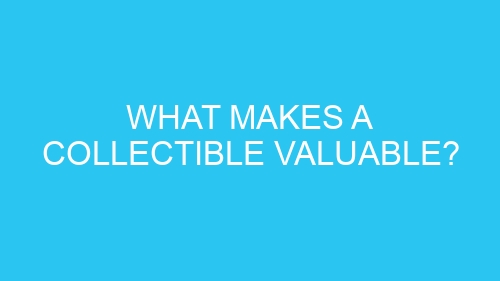-
Table of Contents
Rarity and Scarcity
What Makes a Collectible Valuable?
Rarity and Scarcity
So, you’ve stumbled upon your great-grandfather’s dusty old stamp collection, and you’re wondering if it’s worth anything more than just a trip to the local post office. Well, my friend, you’ve come to the right place! In this article, we’ll be exploring the fascinating world of collectibles and what makes them valuable. Today, we’ll be diving into the first factor that can make a collectible worth its weight in gold: rarity and scarcity.
Now, let’s get one thing straight. When we talk about rarity, we’re not referring to that one sock that always seems to disappear in the laundry. No, no, we’re talking about something much more exciting – the idea that there are only a limited number of a particular item in existence. Think of it as the holy grail of collectibles. The rarer an item is, the more valuable it becomes. It’s like finding a unicorn in your backyard – except instead of a mythical creature, it’s a vintage baseball card.
But how do you determine if something is truly rare? Well, it’s all about supply and demand, my friend. If there’s a high demand for a particular item, but only a limited supply, you’ve hit the jackpot. Take, for example, the infamous T206 Honus Wagner baseball card. There are only about 60 of these bad boys in existence, making them one of the most sought-after collectibles in the world. So, if you happen to stumble upon one of these gems, you might want to consider retiring early.
Now, let’s talk about scarcity. Picture this: you’re at a flea market, and you spot a vintage Barbie doll from the 1960s. You do a quick Google search and find out that there are thousands of these dolls floating around on eBay. Does that mean it’s not valuable? Not necessarily. You see, scarcity is all about the condition and availability of an item. Sure, there may be thousands of those Barbie dolls out there, but how many of them are still in mint condition, with their original packaging? That’s where the value lies.
So, my dear reader, the key to determining the value of a collectible lies in its rarity and scarcity. The rarer an item is, the more valuable it becomes. And if you can find something that is both rare and scarce, well, you’ve hit the jackpot. It’s like finding a needle in a haystack, except instead of a needle, it’s a limited edition action figure.
But before you start rummaging through your attic in search of hidden treasures, let’s take a moment to appreciate the humor in all of this. Collectibles, after all, are just things – objects that hold sentimental value for some and monetary value for others. So, whether you’re a serious collector or just someone who enjoys the thrill of the hunt, remember to have fun along the way. After all, what’s the point of collecting if you can’t share a laugh or two?
In conclusion, rarity and scarcity are two factors that can make a collectible valuable. The rarer an item is, the more sought-after it becomes. And if you can find something that is both rare and scarce, well, you’ve struck gold. So, go ahead and dust off that stamp collection or dig through your grandmother’s jewelry box – you never know what hidden treasures you might find. And remember, in the world of collectibles, a little humor goes a long way. Happy hunting!
Historical Significance and Authenticity
What Makes a Collectible Valuable?
When it comes to collectibles, there are a few key factors that determine their value. One of the most important factors is historical significance. After all, who wants to collect something that has no interesting story behind it? It’s like collecting dust bunnies under your bed – sure, they might be old, but they’re not exactly fascinating.
So, what exactly does historical significance mean? Well, it means that the collectible has some sort of connection to a significant event or person in history. For example, a signed copy of the Declaration of Independence would be considered highly valuable because it represents a pivotal moment in American history. On the other hand, a random sock that George Washington wore one time probably wouldn’t be worth much, unless you’re really into old socks.
But historical significance isn’t the only thing that makes a collectible valuable. Authenticity is also a crucial factor. You see, there are a lot of fakes out there in the world of collectibles. It’s like a game of hide and seek, but instead of hiding, the fakes are pretending to be something they’re not. Sneaky little devils.
So, how can you tell if a collectible is authentic? Well, there are a few ways to spot a fake. One way is to look for any inconsistencies in the item’s design or materials. For example, if you’re looking at a supposed ancient artifact and it’s made of plastic, that’s a pretty big red flag. Unless, of course, ancient civilizations were secretly using Tupperware.
Another way to determine authenticity is through provenance. Provenance is just a fancy word for the item’s history of ownership. If you can trace the collectible back to a reputable source, then chances are it’s the real deal. On the other hand, if the item’s history is as murky as a swamp, you might want to proceed with caution.
Now, let’s talk about the fun part – the humor. Collectibles can be serious business, but that doesn’t mean we can’t have a little fun along the way. After all, who wants to spend their time collecting boring old things? Not me, that’s for sure.
So, let’s inject a little humor into the world of collectibles. Imagine if you stumbled upon a collectible that was both historically significant and authentic, but it was also ridiculously silly. Like a pair of Abraham Lincoln’s underwear with a funny slogan on them. Now that’s a collectible I would pay top dollar for!
In conclusion, historical significance and authenticity are two key factors that determine the value of a collectible. Without these factors, a collectible is just another piece of junk cluttering up your shelves. So, the next time you’re out hunting for collectibles, keep an eye out for those items that have a fascinating story to tell and can be traced back to a reputable source. And hey, if you come across something that’s both historically significant and hilariously absurd, don’t forget to give me a call. I’ll be the first in line to add it to my collection.
Condition and Preservation
What Makes a Collectible Valuable?
Condition and Preservation
When it comes to collectibles, one of the most important factors that determines their value is their condition. You see, just like a fine wine, collectibles can age gracefully or turn into a moldy mess. And let me tell you, nobody wants a moldy mess in their collection!
So, what exactly do we mean by “condition”? Well, it’s all about how well the collectible has been preserved over the years. Has it been kept in a climate-controlled environment, away from the prying hands of children and the destructive paws of pets? Or has it been left to gather dust in a damp basement, where it’s been used as a chew toy by the resident rodents?
Now, I don’t mean to scare you, but the truth is that the condition of a collectible can make or break its value. A pristine, untouched item will fetch a much higher price than one that’s been beaten up and worn down. It’s like the difference between a brand-new sports car and a rusty old jalopy. Sure, they both have wheels and an engine, but which one would you rather take for a spin?
But fear not, my fellow collectors! There are ways to preserve and protect your precious treasures. First and foremost, keep them away from direct sunlight. Just like a vampire, collectibles don’t fare well in the sun. UV rays can fade colors and cause materials to deteriorate faster than you can say “Dracula.”
Next, make sure to store your collectibles in a cool, dry place. Moisture is the enemy here, my friends. It can lead to mold, mildew, and all sorts of nasty things that will turn your once-pristine collectible into a slimy mess. And trust me, nobody wants a slimy mess in their collection. Well, maybe some people do, but that’s a whole other story.
Another important aspect of preservation is proper handling. You wouldn’t want to accidentally drop your collectible or smudge it with your greasy fingers, would you? No, of course not! So, always handle your treasures with care, using gloves if necessary. And please, for the love of all things collectible, don’t eat while handling your items. Nobody wants to find a half-eaten sandwich stuck to their vintage comic book.
Now, I know what you’re thinking. “But what if my collectible is already in less-than-perfect condition?” Well, my friend, all hope is not lost. There are experts out there who specialize in restoring collectibles to their former glory. They can work magic on a scratched record or a torn poster, making it look as good as new. Of course, this comes at a price, but if the collectible is rare and valuable enough, it might be worth the investment.
In conclusion, the condition and preservation of a collectible play a crucial role in determining its value. A well-preserved item will always fetch a higher price than one that’s been neglected or mistreated. So, take good care of your treasures, my fellow collectors, and remember: a little TLC can go a long way in the world of collectibles. Now, if you’ll excuse me, I have some vintage action figures to dust off.

